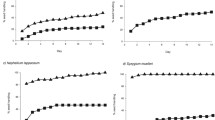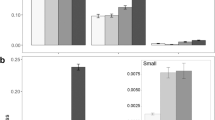Abstract
Natural seed deposition patterns and their effects on post-dispersal seed fate are critical to tropical tree recruitment. The major dispersal agents of the large-seeded tree Canarium euphyllum in Khao Yai National Park, Thailand, are large frugivorous birds such as hornbills, which generated spatially heterogeneous seed deposition patterns because they regurgitated seeds at perching trees and conspecific and heterospecific feeding trees. We investigated the fate of seeds dispersed in this manner using seed removal experiments and automatic camera trapping. Seeds placed experimentally around conspecific feeding trees had higher removal rates than seeds placed elsewhere. These effects were likely mediated by two seed-eating rodents, the Indochinese ground squirrel (Menetes berdmorei) and the giant long-tailed rat (Leopoldamys sabanus). Consequently, the spatial patterns generated by hornbills had consequences for post-dispersal seed fates, particularly whether or not the seeds were removed by rodents. Primary dispersal by hornbills does alter seed fate by altering the probability of rodent–seed interaction, but the ultimate impact of dispersal by hornbills will depend on how important rodent scatterhoarding is to seed germination and seedlings. Given that major seed dispersers of C. euphyllum are now absent or rare in degraded forests in tropical Asia, it is becoming increasingly important to understand the roles of scatterhoarding rodents in these altered habitats in this region.

Similar content being viewed by others
References
Andresen E, Levey DJ (2004) Effects of dung and seed size on secondary dispersal, seed predation, and seedling establishment of rain forest trees. Oecologia 139:45–54
Asquith NM, Terborgh J, Arnold AE, Riveros CM (1999) The fruits the agouti ate: Hymenaea courbaril seed fate when its disperser is absent. J Trop Ecol 15:229–235
Beck H (2006) A review of peccary–palm interactions and their ecological ramifications across the Neotropics. J Mammal 87:519–530
Blate GM, Peart DR, Leighton M (1998) Post-dispersal predation on isolated seeds: a comparative study of 40 tree species in a Southeast Asian rainforest. Oikos 82:522–538
Bohning-Gaese K, Gaese BH, Rabemanantsoa SB (1999) Importance of primary and secondary seed dispersal in the Malagasy tree Commiphora guillaumini. Ecology 80:821–832
Brewer SW, Rejmanek M (1999) Small rodents as significant dispersers of tree seeds in a Neotropical forest. J Veg Sci 10:165–174
Brewer SW (2001) Predation and dispersal of large and small seeds of a tropical palm. Oikos 92:245–255
Chayamarit K (2006) Plants of Khao Yai National Park. National Park, Wildlife and Plant Conservation Department, Ministry of Natural Resources and Environment, Bangkok, Thailand
Corlett RT (2002) Frugivory and seed dispersal in degraded tropical east Asian landscapes. In: Levey DJ, Silva WR, Galetti M (eds) Seed dispersal and frugivory: ecology, evolution and conservation. CABI Publishing, New York, pp 451–465
Dennis AJ, Westcott DA (2006) Reducing complexity when studying seed dispersal at community scales: a functional classification of vertebrate seed dispersers in tropical forests. Oecologia 149:620–634
Farwig N, Bohning-Gaese K, Bleher B (2006) Enhanced seed dispersal of Prunus africana in fragmented and disturbed forests? Oecologia 147:238–252
Feer F, Forget PM (2002) Spatio-temporal, variations in post-dispersal seed fate. Biotropica 34:555–566
Forget PM (1990) Seed dispersal of Vouacapoua americana (Caesalpiniaceae) by caviomorph rodents in French Guiana. J Trop Ecol 6:459–468
Forget PM, Milleron T (1991) Evidence for secondary seed dispersal by rodents in Panama. Oecologia 87:596–599
Forget PM, Vander Wall SB (2001) Scatter-hoarding rodents and marsupials: convergent evolution on diverging continents. Trends Ecol Evol 16:65–67
Forget PM, Lambert JE, Hulme PE, Vander Wall SB (2005) Seed fate: predation, dispersal and seedling establishment. CAB International, Wallingford, UK
Forget PM, Wenny DG (2005) How to elucidate seed fate? A review of marking methods used to study seed removal and secondary seed dispersal. In: Forget PM, Lambert J, Hulme PE, Vander Wall SB (eds) Seed fate: predation, dispersal and seedling establishment. CABI Publishing, Wallingford, UK, pp 379–394
Ganesh T, Davidar P (2005) Fruiting phenology and pre-dispersal seed predation in a rainforest in southern Western Ghats, India. In: Dew JL, Boubli JP (eds) Tropical fruits and frugivores: the search for strong interactors. Zoological Society of San Diego, San Diego, CA, pp 139–154
Hamajima N (2000) Clinical studies by multivariate analysis. The University of Nagoya Press, Nagoya
Holbrook KM, Smith TB (2000) Seed dispersal and movement patterns in two species of Ceratogymna hornbills in a West African tropical lowland forest. Oecologia 125:249–257
Hoshizaki K, Hulme PE (2002) Mast seeding and predator–mediated indirect interactions in a forest community: evidence from post-dispersal fate of rodent-generated caches. In: Levey DJ, Silva WR, Galetti M (eds) Seed dispersal and frugivory: ecology, evolution and conservation. CABI Publishing, New York, pp 227–239
Hulme PE (2002) Seed-eaters: seed dispersal, destruction and demography. In: Levey DJ, Silva WR, Galetti M (eds) Seed dispersal and frugivory: ecology, evolution and conservation. CABI Publishing, New York, pp 257–273
Ickes K, Dewalt SJ, Thomas SC (2003) Resprouting of woody saplings following stem snap by wild pigs in a Malaysian rain forest. J Ecol 91:222–233
Jansen PA, Bongers F, Hemerik L (2004) Seed mass and mast seeding enhance dispersal by a neotropical scatter-hoarding rodent. Ecol Monogr 74:569–589
Kitamura S, Yumoto T, Poonswad P, Chuailua P, Plongmai K, Maruhashi T, Noma N (2002) Interactions between fleshy fruits and frugivores in a tropical seasonal forest in Thailand. Oecologia 133:559–572
Kitamura S, Suzuki S, Yumoto T, Poonswad P, Chuailua P, Plongmai K, Noma N, Maruhashi T, Suckasam C (2004a) Dispersal of Aglaia spectabilis, a large-seeded tree species in a moist evergreen forest in Thailand. J Trop Ecol 20:421–427
Kitamura S, Yumoto T, Poonswad P, Noma N, Chuailua P, Plongmai K, Maruhashi T, Suckasam C (2004b) Pattern and impact of hornbill seed dispersal at nest trees in a moist evergreen forest in Thailand. J Trop Ecol 20:545–553
Kitamura S, Suzuki S, Yumoto T, Chuailua P, Plongmai K, Poonswad P, Noma N, Maruhashi T, Suckasam C (2005) A botanical inventory of a tropical seasonal forest in Khao Yai National Park, Thailand: implications for fruit–frugivore interactions. Biodivers Conserv 14:1241–1262
Kitamura S, Suzuki S, Yumoto T, Poonswad P, Chuailua P, Plongmai K, Maruhashi T, Noma N, Suckasam C (2006) Dispersal of Canarium euphyllum (Burseraceae), a large-seeded tree species, in a moist evergreen forest in Thailand. J Trop Ecol 22:137–146
McConkey KR (2005) Influence of faeces on seed removal from gibbon droppings in a dipterocarp forest in Central Borneo. J Trop Ecol 21:117–120
Meehan HJ, Hillyard K, Guy M (2003) Retention time of beads in captive Torres Imperial Pigeons, Ducula spilorrhoa spilorrhoa. Notornis 50:167–168
Nathan R, Muller-Landau HC (2000) Spatial patterns of seed dispersal, their determinants and consequences for recruitment. Trends Ecol Evol 15:278–285
Pattanavibool A, Dearden P (2002) Fragmentation and wildlife in montane evergreen forests, northern Thailand. Biol Conserv 107:155–164
Plongmai K, Poonswad P, Sukkasem C, Chuailua P (2005) The availability of ripe fruits in the annual hornbill life cycle. In: Lum S, Poonswad P (eds) The ecology of hornbills: reproduction and populations. Pimdee Karnpim Co. Ltd., Bangkok, Thailand, pp 131–142
Pooma R (1999) A preliminary account of Burseraceae in Thailand. Thai For Bull 27:53–82
Poonswad P, Tsuji A (1994) Ranges of males of the Great Hornbill Buceros bicornis, Brown Hornbill Ptilolaemus tickelli and Wreathed Hornbill Rhyticeros undulatus in Khao Yai National Park, Thailand. Ibis 136:79–86
Poonswad P, Chuailua P, Plongmai K, Nakkuntod S (1998) Phenology of some Ficus species and utilization of Ficus sources in Khao Yai National Park, Thailand. In: Poonswad P (ed) The Asian hornbills: ecology and conservation (Thai Studies in Biodiversity No. 2). BIOTEC, NSTDA, Bangkok, Thailand, pp 227–244
Russo SE (2003) Responses of dispersal agents to tree and fruit traits in Virola calophylla (Myristicaceae): implications for selection. Oecologia 136:80–87
Russo SE (2005) Linking seed fate to natural dispersal patterns: factors affecting predation and scatter-hoarding of Virola calophylla seeds in Peru. J Trop Ecol 21:243–253
Schupp EW, Milleron T, Russo SE (2002) Dissemination limitation and the origin and maintenance of species-rich tropical forests. In: Levey DJ, Silva WR, Galetti M (eds) Seed dispersal and frugivory: ecology, evolution and conservation. CABI Publishing, New York, pp 19–33
Sodhi NS, Koh LP, Brook BW, Ng PKL (2004) Southeast Asian biodiversity: an impending disaster. Trends Ecol Evol 19:654–660
Srikosamatara S, Hansel T (1996) Mammals of Khao Yai National Park. Green World Foundation, Bangkok, Thailand
Suzuki S, Kitamura S, Kon M, Poonswad P, Chuailua P, Plongmai K, Yumoto T, Noma N, Maruhashi T, Wohandee P (2006) The foraging activity patterns of frugivorous or omnivorous animals on the forest floor of a tropical seasonal forest in Thailand, with reference to seasonal changes. Nat Hist Bull Siam Soc 54 (in press)
Suzuki S, Kitamura S, Kon M, Poonswad P, Chuailua P, Plongmai K, Yumoto T, Noma N, Maruhashi T, Wohandee P (2007) Fruit visit patterns of small mammals on the forest floor in a tropical seasonal forest of Thailand. Tropics 16 (in press)
Terborgh J, Pitman N, Silman M, Schichter H, Nunez PV (2002) Maintenance of tree diversity in tropical forests. In: Levey DJ, Silva WR, Galetti M (eds) Seed dispersal and frugivory: ecology, evolution and conservation. CABI Publishing, New York, pp 1–17
Theimer TC (2001) Seed scatterhoarding by white-tailed rats: consequences for seedling recruitment by an Australian rain forest tree. J Trop Ecol 17:177–189
Theimer TC (2003) Intraspecific variation in seed size affects scatterhoarding behaviour of an Australian tropical rain-forest rodent. J Trop Ecol 19:95–98
Theimer TC (2005) Rodent scatterhoarders as conditional mutualists. In: Forget PM, Lambert JE, Hulme PE, Vander Wall SB (eds) Seed fate: predation, dispersal and seedling establishment. CABI Publishing, Wallingford, UK, pp 283–296
Vander Wall SB (1990) Food hoarding in animals. University of Chicago Press, Chicago, IL
Vander Wall SB (2003) Effects of seed size of wind-dispersed pines (Pinus) on secondary seed dispersal and the caching behavior of rodents. Oikos 100:25–34
Vander Wall SB, Kuhn KM, Gworek JR (2005) Two-phase seed dispersal: linking the effects of frugivorous birds and seed-caching rodents. Oecologia 145:282–287
Walker S, Rabinowitz A (1992) The small-mammal community of a dry-tropical forest in central Thailand. J Trop Ecol 8:57–71
Xiao ZS, Zhang ZB, Wang YS (2004) Dispersal and germination of big and small nuts of Quercus serrata in a subtropical broad-leaved evergreen forest. For Ecol Manage 195:141–150
Xiao ZS, Zhang ZB (2006) Nut predation and dispersal of Harland Tanoak Lithocarpus harlandii by scatter-hoarding rodents. Acta Oecol 29:205–213
Yasuda M, Miura M, Hussein NA (2000) Evidence for food hoarding behaviour in terrestrial rodents in Pasoh forest reserve, a Malaysian lowland rain forest. J Trop For Sci 12:164–173
Yasuda M, Miura S, Ishii N, Okuda T, Hussein NA (2005) Fallen fruits and terrestrial vertebrate frugivores: a case study in a lowland tropical rain forest in Peninsular Malaysia. In: Forget PM, Lambert JE, Hulme PE, Vander Wall SB (eds) Seed fate: predation, dispersal and seedling establishment. CABI Publishing, Wallingford, UK, pp 151–174
Acknowledgments
We are grateful to the National Research Council of Thailand and National Park Division of the Royal Forest Department of Thailand for allowing us to conduct the activity in KY. We extend our hearty thanks to the staff at KY. We thank B. Saengthong, P. Chuailua, K. Plongmai, S. Chuailua, S. Nakkuntod, S. Sanguanchat, N. Jirawatk, and all staff of Thailand Hornbill Project for supporting our field works as well as their kind encouragement. We would like to thank T. Maruhashi, and N. Noma for useful suggestions. T.C. Theimer and anonymous referees made useful comments to a previous version of the paper. This research is partly supported by a Research Fund of the Japan Society for the Promotion of Science (#1357006) and JSPS Research Fellowships for Young Scientists for S. Kitamura.
Author information
Authors and Affiliations
Corresponding author
About this article
Cite this article
Kitamura, S., Yumoto, T., Poonswad, P. et al. Rare seed-predating mammals determine seed fate of Canarium euphyllum, a large-seeded tree species in a moist evergreen forest, Thailand. Ecol Res 23, 169–177 (2008). https://doi.org/10.1007/s11284-007-0350-7
Received:
Accepted:
Published:
Issue Date:
DOI: https://doi.org/10.1007/s11284-007-0350-7




